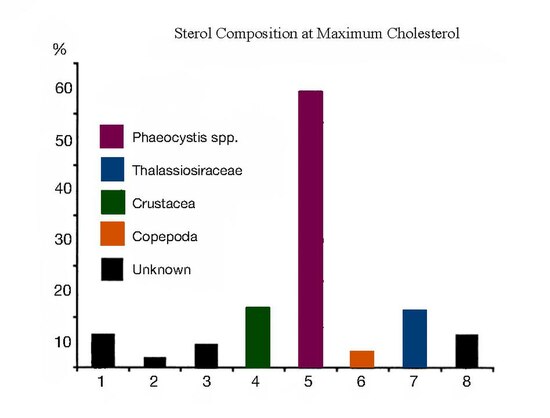Desmosterol
[3] In 2014, desmosterol was named the Molecule of the Year 2012 by the International Society for Molecular and Cell Biology and Biotechnology Protocols and Researches (ISMCBBPR).The presence of desmosterol in oceans and lakes has the potential to diagnose anoxic conditions and to study trends in steroid chemistry during the early stages of diagenesis.[5] Desmosterol has been found in high yields in samples of Rhizosolenia setigera (Brightwell) in Western Svalbard,[6] and from surface sediment off of the Peruvian Shelf sediment-water interface.Additionally, small amounts of desmosterol have been found in other crustaceans such as lobster and shrimp in the homarus americanus and pandalus borealis species.In 1967, desmosterol was also identified in large percentages in the red algae Laurencia pinnatifida, Polusiphonia nigrescens, Porphyra purpurea, and Dulse (Rhodymenia palmata) after previously having been undetected.[19] Diatoms and Silicoflagellates are classes of phytoplankton present in sedimentary material from the sediment water interface in the Peruvian Shelf region.






IUPAC nameCAS NumberChEMBLChemSpiderECHA InfoCardIUPHAR/BPSPubChemCompTox DashboardSMILESChemical formulaMolar massMelting pointstandard statephytoplanktoncholesteroldesmosterolosis24-dehydrocholesterol reductaseMolecule of the YearISMCBBPRsterolsanoxicdiagenesisbalanus glandulabarnaclehomarus americanuspandalus borealisbiosynthesisebarnaclesred algaeannelidamolluscsexogenousLaurencia pinnatifidaPorphyra purpureaDulse (Rhodymenia palmata)gas liquid chromatographyKonrad BlochmevalonateFeodor Lynenmarine spongesbiomarkerpreservation potentialdiatomsRhodophyceaetaxonomiccopepodsozonolysisinfrared spectroscopymass spectrometryTriparanolBibcodebioRxivsteroidmetabolic intermediatesMevalonate pathwayHMG-CoAAcetyl-CoAAcetoacetyl-CoAHMB-CoAKetone bodiesAcetoneAcetoacetic acidβ-Hydroxybutyric acidMevalonic acidPhosphomevalonic acid5-Diphosphomevalonic acidIsopentenyl pyrophosphateDimethylallyl pyrophosphateGeranyl pyrophosphateGeranylgeranyl pyrophosphateCarotenoidPrephytoene diphosphatePhytoeneNon-mevalonate pathwayCDP-MECDP-MEPHMB-PPFarnesyl pyrophosphateSqualene2,3-OxidosqualeneLanosterolZymosterolLathosterol7-Dehydrocholesterol7-DehydrodesmosterolSteroid hormones22R-Hydroxycholesterol20α,22R-DihydroxycholesterolSitosterolCycloartenolObtusifoliol4α-methylfecosterolIsofucosterol24-MethylenelophenolPhytosterolsErgocalciferolFecosterolEpisterolErgostatrienolErgosterol